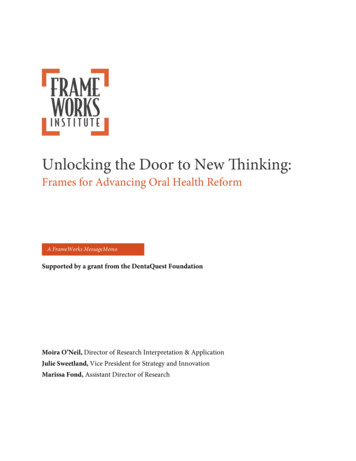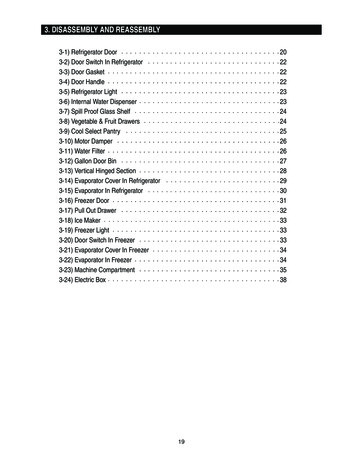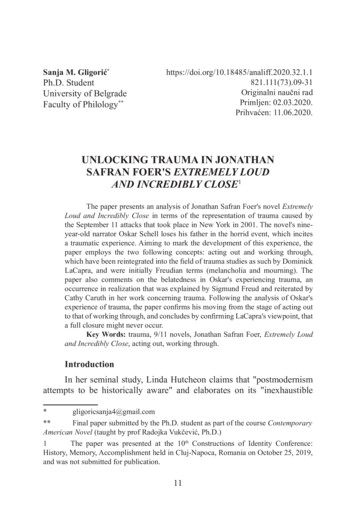
Transcription
Unlocking the Door to New Thinking:Frames for Advancing Oral Health ReformA FrameWorks MessageMemoSupported by a grant from the DentaQuest FoundationMoira O’Neil, Director of Research Interpretation & ApplicationJulie Sweetland, Vice President for Strategy and InnovationMarissa Fond, Assistant Director of Research
Table of ContentsIntroduction .3Anticipating Public Thinking.5What is oral health? Functioning system vs. no cavities.5Where should Americans access oral health care? Multiple sites vs. the dentist’s office.6What threatens oral health? Environments vs. individuals .7What explains disparities in oral health? Structural inequality vs. “cultural” differences.8What are the consequences of oral health problems? Population effects vs. individual troubles .8How can oral health be improved? Public health approach vs. three simple things .10Redirections .12AVOID framing that narrows the scope of oral health to the teeth.13ADVANCE images, definitions, and explanations that connect oral health to overall health. .13AVOID unframed data about disparities.14ADVANCE the value of Targeted Justice as the opening of a fuller story about promoting equitable access toquality care. .14AVOID leaving “prevention” undefined, undescribed, or individualized. .16ADVANCE the value of Responsible Management when making an economic case for widespread preventionstrategies. .16AVOID “zooming in” on individual cases to illustrate systemic problems. .20ADVANCE understanding of the systemic barriers to oral health by comparing barriers to “locked doors” andsolutions that promote access to “keys.” .21AVOID leaving solutions to the public’s imagination. .23ADVANCE the idea that oral health involves a team of professionals that work across the community.24Moving Forward .25About the FrameWorks Institute.26Appendix A: Which frame “works”? That’s an empirical question. .27Scales and questions about knowledge, attitudes, and policy preferences .27
IntroductionWhen Chapin Harris and Horace Hayden approached the University of Maryland in 1840 to propose theintegration of dentistry into medical training, the response would reverberate in American public healthacross the next two centuries. According to Mary Otto, author of Teeth: Beauty, Inequality, and theStruggle for Oral Health in America, the medical school dismissed dentistry as irrelevant to the training ofprospective doctors, characterizing the care of teeth as a “mechanical” issue rather than a medical one.After this historic rebuff, the United States’ first dental school was founded as an independent entity.Thus, the complete separation of the dental and medical health care systems was set into motion—withprofound and lasting consequences. Today, a few forward-thinking integrated models exist, but in generalthere is too little communication between dental and medical health systems, leading to missedopportunities to further the knowledge base for prevention and treatment efforts that address oral healthissues in the context of overall health. Private insurance for these two types of care is typically handledunder separate plans and by separate insurers. Oral health coverage is offered less often through employeebenefit programs than medical coverage. This contributes to a general sense that oral health care is a “niceextra” rather than essential. Perhaps it is not surprising, then, that Americans fail to appreciate theconnections between oral health and overall health.The bifurcation of these systems is more than a perception problem. The separation has cascadingconsequences on health care costs and health equity. Lacking adequate coverage for oral health, theuninsured may defer treatment until problems become acute, then seek treatment in emergency rooms,where are there are neither dentists to treat the immediate problem nor the kinds of connections to oralhealth care providers that ensure appropriate referrals and follow-up care. In the absence of systems andstructures that ensure access to adequate oral health care, there are profound disparities in oral health careoutcomes that fall along the predictable lines of race, place, and socioeconomic status.Since the release of the surgeon general’s Oral Health in America report in 2000, public health advocateshave made important progress in addressing these problems, but there is more work to be done. Onesignificant task ahead involves the meaning-making work that every movement must undertake. Becauseoral health advocates are working toward major, structural changes, they must also continue to cultivatepublic understanding of the problem and generate broad support for their solutions.Understanding the need for effective ways to elevate and explain oral health as a matter of public concern,the DentaQuest Foundation commissioned the FrameWorks Institute to conduct a Strategic FrameAnalysis —a multi-method investigation that combines theory and methods from different social sciencedisciplines to arrive at reliable, research-based recommendations for reframing a social issue. Figure 1outlines the set of questions that were pursued, the methods used to investigate them, and details onsamples sizes. This MessageMemo outlines the major findings of these studies and explains theirimplications for communications, outreach, and advocacy.Unlocking the Door to New Thinking: Frames for Advancing Oral Health Reform 3
The MessageMemo unfolds in three parts: Anticipating Public Thinking outlines how Americans mentally model oral health and relatedissues, and pinpoints the implications of these patterns for advancing an informed publicconversation. Redirections outlines a series of thoroughly tested communications tools and techniques forreframing oral health. Moving Forward offers concluding thoughts and a call to action.Figure 1: Research baseWhat communications research does a field need to reframe an issue?WHAT DOES THE RESEARCH ON ORAL HEALTH SAY?To discern expert consensus on oral health, FrameWorks interviewed 10 leading researchers, practitioners, advocates,and leaders in the field of oral health. These data, collected in late 2015, were supplemented by a literature review.HOW DOES THE PUBLIC THINK?To document the cultural models that Americans draw on to make sense of oral health, FrameWorks conducted indepth cognitive interviews with members of the public and analyzed transcripts to identify the implicit, sharedunderstandings and assumptions that structure public opinion. Twenty interviews were conducted in Los Angeles, CA;Baltimore, MD; Nashville, TN; Chicago, IL; and Philadelphia, PA, in November and December of 2015.WHAT IS THE PUBLIC HEARING FROM THE FIELD AND THE MEDIA?To characterize the public discourse that shapes the cultural and policy climate around oral health issues, FrameWorksanalyzed both media coverage and communications from influential oral health advocacy organizations. Researcherscoded 123 media pieces and 184 pieces of non-governmental organization (NGO) communications to identify theexisting framing techniques and pinpoint their likely effects on people’s understandings.WHAT FRAMES CAN SHIFT THINKING?To systematically identify effective ways of talking about oral health, FrameWorks researchers developed alternativemessages and tested them with ordinary Americans. A set of related methods were used to explore, winnow, and refinepossible reframes: A panel of grassroots advocates were invited to comment on possible messages and speculate on the usability ofthe frames in the communities where they work. A set of on-the-street interviews allowed for rapid, face-to-face testing of frame elements for their ability toprompt more productive and robust understandings. A round of 36 interviews was conducted in Miami, FL, andAnnapolis, MD, in spring 2016. A second round of interviews (a total of 64) was conducted in Minneapolis, MN, andBaltimore, MD, in summer 2016. A series of experimental surveys, involving a representative sample of 7,000 respondents, tested the effects ofexposure to a variety of frames on public understanding, attitudes, and support for programs and policies. A series of qualitative tests (called “Persistence Trials”) further probed the effectiveness of the metaphor. Thesetrials were was conducted with 24 participants in Phoenix, AZ, and Baltimore, MD, in January of 2017.All told, more than 7,100 people from across the United States were included in this research.Unlocking the Door to New Thinking: Frames for Advancing Oral Health Reform 4
Anticipating Public ThinkingBefore designing communications on a complex issue, it is helpful to anticipate how and why thosecommunications might go awry. When strong conceptual models exist but are at odds with research andevidence, advocates need to reach for strategies that can shift perspectives and allow people to incorporatenew ways of thinking. A systematic assessment of where, and how, public thinking differs from expertconsensus is therefore a crucial resource for setting communications priorities, designing a strategy tomeet those priorities, and selecting framing tactics. In this section, FrameWorks offers its analysis of themost important differences for advocates to anticipate and their implications for an overarchingreframing strategy.What is oral health? Functioning system vs. no cavitiesExperts characterize good oral health as “not just” the absence of disease, but the full ability to use themouth for everyday functions such as eating, smiling, speaking, or kissing. While oral health focusesspecifically on issues presenting in the mouth—including the teeth, tongue, gums, and the entire oralcavity—experts note that oral health is inextricable from physical and mental health. There are manyexamples of how oral health affects, and is affected by, the health of the whole body. When oral health iscompromised (for instance, by the presence of harmful bacteria) it can lead to increased risk for diseasessuch as cardiovascular disease or stroke. Oral health can be compromised in a variety of ways, includingcavities, gum disease, viral or fungal infections in the mouth, oral cancer, or trauma or injury to any partof oral cavity. Oral disease has been linked to complications in pregnancy and childbirth and torespiratory, gastrointestinal, rheumatologic, and immunological issues. The influence goes the other way,too: other health conditions can affect the mouth, as when medication side effects lead to a dry mouth andthereby increase the risk of cavities or gum disease. Furthermore, experts note that oral health has uniquepsychological and social elements. Because the mouth is a prominent part of personal appearance, peoplewith visible signs of oral disease are negatively judged and socially stigmatized, with consequences fortheir mental health as well as other influences on wellbeing, such as employment outcomes.The American public has a much narrower default definition of oral health: it’s about teeth, and healthyteeth are teeth without cavities. When prompted to think about “the mouth,” people will venture intospeculating about how it is connected to overall health, but their reasoning reveals a limitedunderstanding. They are likely to offer one of two examples: the mouth is used to eat, and eatinginfluences health; and the mouth is used to breathe, and breathing is essential for life. A single mechanism—the process of introducing substances into the body—is at work in both examples. The othermechanisms that oral health experts consider—infection, trauma, cancerous growth—are notably missingfrom Americans’ causal reasoning about why a healthy mouth matters.To build support for the comprehensive reforms needed to improve oral health access, outcomes, andequity, advocates need strategies that broaden the issue of oral health “beyond teeth” and clarify themechanisms that connect oral health with overall health.Unlocking the Door to New Thinking: Frames for Advancing Oral Health Reform 5
Where should Americans access oral health care? Multiple sites vs. the dentist’sofficeExperts contend that improving oral health outcomes will require that many kinds of providers offer oralhealth services and that effective approaches embed oral health services across community institutions.They note the benefits that have accrued from initiatives to provide oral health services in the places wherepeople already gather or go: Head Start programs, schools, pediatricians’ offices, or community healthcenters. And they point to ways in which the system could be further reimagined to provide care inremote areas or for other hard-to-reach populations. One such creative option is teledentistry, wherelocally based oral health providers, like dental practitioners, can use communications technology toconsult with dentists or oral surgeons based elsewhere, thus reducing the problems associated withshortages of professionals in remote areas. The underlying assumption and overarching theme acrossthese examples is that oral health can and should be addressed in many places, and in many ways, by avariety of health providers.In contrast, Americans hold a shared assumption that Dentists’ Offices Are the System. This model involvesthe thinking that the only relevant actors in oral health are those who are associated with a stand-alonedentistry practice: dentists, dental hygienists, and receptionists. These providers are understood as doing alimited set of tasks: people think of them as primarily extending and enhancing patients’ own efforts tokeep their teeth clean, and remaining on standby to repair damage when necessary. Furthermore, eachpractice is thought of as something like an island unto itself. Each office stands alone, disconnected anddivorced from other dentistry practices, and in an entirely different world from the overall health caresystem.The assumption that Dentists’ Offices Are the System has important implications for talking aboutcommunity-based systems of oral health care. If the only important actors are dentists, hygienists, andreceptionists, it will be difficult for people to understand proposals that involve providers beyond thesefamiliar types, much less proposals to tackle issues beyond the provision of oral health care. To the extentthat the system is thought of as tantamount to dentists’ offices, the public will struggle to understand howoral health care can be better integrated into our health systems or to connect oral health to proposals forhealth care reform. The Dentists’ Offices Are the System model also structures how people think aboutsystemic problems like affordability. Because practices are understood to operate in isolation, it is easy forthe public to imagine the dentist as self-interested and therefore perhaps untrustworthy– motivated tocharge arbitrary fees, inflate costs, or upsell services that patients don’t need or understand.To bring Americans along in rethinking our system to better fit the country’s oral health needs,communicators need ways to foreground the idea that there is a system beyond stand-alone dentistrypractices. To build support for reforms that broaden access to care, like expanding provider licensingoptions, communicators will need strategies to highlight a more diverse set of actors and places that arepart of the oral health system of prevention and care. To build support for reforms that take a publichealth approach to oral health—like fluoridation—communicators need strategies for highlightingprevention and intervention efforts beyond biannual visits to the dentist.Unlocking the Door to New Thinking: Frames for Advancing Oral Health Reform 6
What threatens oral health? Environments vs. individualsExperts emphasized that a constellation of social, political, and biological factors influence oral health.They note that self-care and personal habits influence outcomes, but simultaneously attend to the ways inwhich these individual behaviors are shaped by social context. Chief among these is the fact that, for somegroups, oral health care is difficult to access. Oral health care is not integrated into patients’ primary care;insurance coverage is often limited for oral health issues; and without insurance coverage, accessing oralhealth care providers is cost prohibitive for many people. There also is an extreme shortage of oral healthprofessionals in certain parts of the country, particularly in rural areas. And even when oral health care isavailable and accessible, experts note that oral health providers are often not trained to deliver culturallyand linguistically appropriate guidance that addresses specific communities’ needs. Finally, expertsexpress frustration that policymakers tend to ignore oral health and that oral health does not get enoughattention at the higher levels of government. They point to the limits of oral health coverage providedthrough public programs such as Medicaid and Medicare.Beyond this policy context, experts point to health literacy issues that influence oral health outcomes. Forinstance, few people are aware that parents’ state of oral health (good or poor) directly affects children inthe earliest stages of life. Infants are born with sterile mouths and acquire populations of bacteria throughordinary interactions with their primary caregivers—a normal, ubiquitous process referred to as “verticaltransmission.” When parents’ mouths are healthy, helpful bacteria is passed along; when parents sufferfrom oral disease, harmful bacteria are shared. Because vertical transmission of bacteria will invariablyoccur, experts note, the goal is to ensure that parents’ mouths are as healthy as possible. In turn, this goalrequires improved oral health literacy among caregivers and the health care providers who influence theirbehavior.Public thinking, in contrast, involves little to no consideration of external influences on oral health.Reasoning from the understanding that oral health is just about teeth, Americans focus narrowly onbrushing, flossing, and eating habits as the primary causes of oral health or the lack thereof. Problems areassumed to be the result of poor personal hygiene–a problem that can be readily solved, as one participantsaid, “with just a 3 toothbrush.” This thinking also reveals an underlying Health Individualism model, apervasive American belief that health is almost entirely under one’s personal control. According to thismental model, wise choices lead to good health, poor choices lead to illness, and everyone has the powerto choose. Thus, the public is unlikely to think about whether quality care is accessible, yet can readilyblame individuals for neglecting to seek medical care when there are symptoms indicating illness ordisease. Similarly, factors beyond individual responsibility—such as the preparation and training of healthcare providers or the role of transmissible disease—are invisible to the public.To elevate oral health as a matter of societal concern—not just a personal matter—advocates must findways to expand public thinking beyond Health Individualism. This is no easy task, as Individualism isarguably the deepest, most pervasive, and most well-established cultural model that Americans hold,shaping thinking about a vast array of social issues, not just oral health. Because cultural models areactivated by the process of association, reframing efforts must scrupulously avoid cues about individualUnlocking the Door to New Thinking: Frames for Advancing Oral Health Reform 7
agency and, instead, consistently advance a frame that directs public attention to the many other factorsthat shape oral health. This reframing will involve, for instance, emphasizing how context can promote orreduce healthy behaviors, rather than merely naming the healthy behaviors themselves. Shifting the issuefrom an individualistic orientation to a public health perspective will also involve establishing that theconsequences of positive or negative oral health outcomes are shared across society, and not limited to theindividuals, families, or populations experiencing them.What explains disparities in oral health? Structural inequality vs. “cultural”differencesExperts locate the root causes of disparities in oral health outcomes in structural factors: the geographicdispersion of oral health care systems, uneven access to linguistically and culturally appropriate oralhealth care services, and differences in health care coverage according to income, to name just a fewsources of inequity. The cumulative effect of these factors is that people who live in marginalizedcommunities—especially in rural areas—have the greatest difficulty accessing oral health care. Reasoningfrom this systemic view, experts recommend multiple policy reforms to reduce disparities. Most involvetargeting specific communities with more resources and better oral health care delivery systems.When asked to consider why some groups of people experience poor oral health more often than others,and what might be done about it, ordinary Americans’ reasoning diverges sharply from that of expertsand advocates. The public relies primarily on the Health Individualism model explained above, concludingthat poor oral health is evidence that people are simply not taking good care of themselves. The solution,therefore, is to provide more information so that they can make healthier choices. The other way that thepublic conceptualizes disparities is through stereotypes (e.g., asserting that people from Appalachia andother rural areas have “bad teeth”). Importantly, there are no structural factors associated with these“cultural” explanations. That is, people don’t connect the absence of water fluoridation or a shortage oforal health care providers in rural areas with their perception that a region has “bad teeth.” They simplyassume that such areas have a preponderance of people with poor personal hygiene and that these failuresof personal responsibility aren’t a matter of public concern.To make the case for promoting greater oral health equity, the field will need to find ways to direct publicattention away from deficit thinking about populations that experience poor oral health and towardsystems thinking about how disparities arise and how they can be redressed. This will require techniquesand tools to explain how structural factors—income, race and ethnicity, language, geographic location—influence oral health outcomes and show how shifts in the system can address disparities.What are the consequences of oral health problems? Population effects vs.individual troublesExperts note that oral health policies and outcomes have measurable consequences for the nation,including economic impacts. One way that oral health affects the economy is through its effect onemployment. Employers are much less likely to hire candidates with visible or untreated oral healthUnlocking the Door to New Thinking: Frames for Advancing Oral Health Reform 8
problems, contributing to chronic unemployment in some segments of workers and setting a cascadingset of economic effects in motion. When oral health problems translate into decades of dampened or lostearning potential, this brings with it a loss of tax revenue and economic activity and an increase in costsassociated with public assistance.Another way that current oral health policies and problems affect the economy is through theircontribution to increased health care costs. When oral health is difficult to access—either because ofinadequate insurance coverage, cost, or other reasons—patients are more likely to develop problems thatcould have been prevented, or defer treatment until the problem becomes severe or acute, then seekemergency treatment. Emergency treatment is more expensive and rarely solves the problem, as it is illsuited to handle chronic health issues, making it likely that emergency care will be sought once again. Inthe process, the emergency system can become overburdened, lowering the quality of care for all. Thecumulative effect is an increase in health care costs, with no commensurate improvement in healthoutcomes. Experts speak with some frustration about this vicious cycle, pointing out that oral healthproblems are readily preventable through sound public health measures.While experts see the interconnections among policy, outcomes, disparities, and associated costs, thepublic works with a decidedly little-picture view of the consequences of oral health issues. Americans’ topof-mind associations with oral health problems are simple and immediate: bad teeth can be painful andmay cause “low self-esteem.” With prompting, people can readily see some ripple effects from thesestarting points—say, missed days of work or a hampered ability to maximize professional opportunities.Importantly, they understand these negative impacts as unfortunate problems for individuals and theirfamilies, while failing to see how they contribute to matters of shared public concern like economicgrowth or the cost of health care.If the public stays stuck in little-picture thinking, meaningful reform will be difficult to achieve. If theproblem is understood to be the occasional toothache and a bit of personal embarrassment, then it’s hardto make sense of the role for policy and programs. Yet care must be taken in elevating the issue. Onecommon method of attempting to reframe the issue—highlighting negative outcomes for certainpopulations—may have unintended consequences. First, it’s easy to imagine a backfire effect in which thepublic interprets data on disparities as evidence that “people who don’t take care of themselves” arecausing serious economic problems that affect us all. Second, making a strongly negative case will dampenthe public’s ability to appreciate the possibility for success. Given the expert perspective that populationwide preventive measures would have dramatic effects and reverberate across social and economic life, itseems wise to find ways to translate this more hopeful point of view to the public.Simply put: to build support for oral health reforms, advocates must find effective ways to foreground thecollective benefits that will accrue from more sensible oral health policies.Unlocking the Door to New Thinking: Frames for Advancing Oral Health Reform 9
How can oral health be improved? Public health approach vs. three simple thingsExperts see oral health issues as completely preventable. When talking about the real possibility oferadicating oral health issues, they focus on public health efforts that reach large numbers of peopleconsistently. The prime example of a successful public health approach is water fluoridation: aninexpensive, unobtrusive, and nearly universal preventive measure that has yielded dramaticimprovements in dental health. Experts go on to list other preventive measures, like screenings and dentalsealants, that, if made widely available, could improve outcomes further. They note that the availabilityand affordability of healthy food plays an important role in oral health, and they connect federal nutritionprograms and policies to oral health outcomes. Similarly, they emphasize that access to affordable, qualityoral health care is an essential piece of effective public policy on oral health, and they argue for a variety ofsignificant changes in current health insurance schemes (e.g., expansion of eligibility for Medicare andMedicaid, increase of oral health coverage in these plans, inclusion of at least some oral health treatmentin private medical insurance). They suggest policies that would better integrate oral health concerns intomedical care, like screenings for oral infections before surgeries or during pregnancy. Even when expertsthink about individual behaviors, they tend to think big, noting that current efforts at promotingawareness have fallen short, and more effective, innovative initiatives to build health literacy are needed.Ordinary Americans also believe that oral health problems can be prevented, but place the responsibilityfor doing so on individuals. The public’s model of prevention involves Three Simple Th
Unlocking the Door to New !inking: Frames for Advancing Oral Health Reform Supported by a grant from the DentaQuest Foundation Moira O’Neil, Director of Research Interpretation & Application Julie Sweetland, Vice President for Strategy and Innovation Marissa Fond










